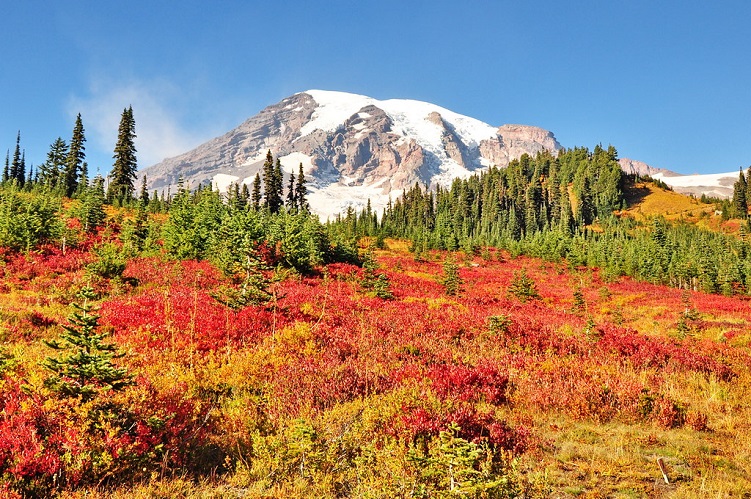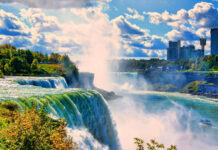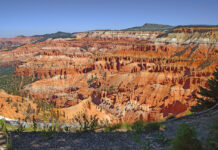
Summer slowly turns to fall. The beauty of that new season is highlighted by cooler temperatures and the leaves changing colors. Indeed, so many people look forward to seeing the verdant green trees become tinted with orange, red, and yellow.
Yes, this colorful transformation occurs every autumn and yet, for nature lovers, it never gets old—especially when there always seems to be new places to see all the fantastic fall foliage. For readers looking for different views beyond the local neighborhood, there are plenty of superb scenic spots across the US. In order to assist you in detailing your calendar of colors, here are the best national parks for fall foliage and when to go.
The Best National Parks For Fall Foliage And When To Go
1. Shenandoah National Park, Virginia

If you like Virginia, the Shenandoah National Park spans an area of nearly 80 thousand acres including part of the rugged Blue Ridge Mountains. If you’re going to stick to your car, the main park road is the popular 105-mile-long Skyline Drive. You can see much of the mountainous ridgeline there.
Expansive Shenandoah National Park features more than 100 miles of countryside. And as fall approaches, the foliage across the land turns sharp shades of orange, red, and yellow. Sources differ as to the best time to check out the fall foliage.
Some say you can see changes in the colors as early as September. Other sources note that the leaves at the higher elevations do not even begin to change until early October. By the middle of October, the numerous colors have made their way down the hills and into the verdant valleys.
In late October the hilltops go brown. Luckily, this park has a special “fall color webcam” that allows people to watch the leaves change color weekly during the peak of the season. That can help you plan your visit too.
(Continued on next page)
The Great Smoky Mountains National Park, North Carolina, And Tennessee

The Great Smoky Mountains National Park includes 522,419 acres in the states of Tennessee and North Carolina. It is thus named because the property straddles the Great Smoky Mountains’ ridgeline, a section of the Blue Ridge Mountains, and a part of the Appalachian Mountains. The best time to see the fall foliage here is from the middle of October into early November.
Veteran visitors say that you will take in the very best views of the 4,000+ miles of fall foliage here at the mid and lower-level elevations. It is here that the leaves of more than 100 species of trees, including scarlet oak, sugar maple, and sweetgum trees, reach their pretty peak. Witness as the green changes to orange, red, yellow, and even purple.
(Continued on next page)
Yosemite National Park, California

The Golden State’s Yosemite National Park is nigh-famous for such waterfalls as Bridalveil, Nevada, and Vernal. Ah, but it spans an area of 759,620 acres so there’s a lot more to see here than waterfalls. Indeed, in 2016 the park set an official visitation record, with more than five million visitors. Just so you know, a number of them came here to enjoy the fall foliage.
The best time to see all the colors is during the peak season which is in the middle of October. For it is then that such trees as Pacific dogwoods and big-leaf maples subtly begin to take on orange and yellow tints. Be sure to check on the park’s website though before you visit because the park began to require reservations to tour the park during peak periods back in 2020.
(Continued on next page)
Olympic National Park, Washington

This popular park includes 922,650 acres. It contains four different areas. They are the alpine areas, the forests of the east side, the Pacific coastline, and the west side’s rainforest.
Fans of fall foliage say that by the middle of October the trees here are usually coated with the usual moss and, more importantly, covered with a multi-colored mix of orange, yellow, and red leaves. They also note that the process starts in the middle of September at the higher elevations along the Pacific coastline.
(Continued on next page)
Hot Springs National Park, Arkansas

Regular readers may already know that the popular adjacent to the city of the same name in central Garland County is famous for its hot springs and is a great place to go camping and hiking as well. What may not be as well-known is this 5,550-acre hotspot is one of the best national parks for fall foliage too.
To help you make your plans, it is important to know that the leaves in the northern part of the state change color by early October. Anywhere else in the state, including the central region where you’ll find this particular park, they change between the end of October into November. So plan your next visit accordingly.
(Continued on next page)
Grand Teton National Park, Wyoming

You will find this national park deep in the heart of Jackson. This park encompasses an area of 310,000 acres. It offers visitors some stunning mountain landscapes and a lovely lakefront view too.
Leaf lovers should visit sometime between early September through the middle of October. The park’s elevation influences when the colors change. Mind you, the weather here also significantly impacts the foliage.
The temperatures tend to drop sooner, and this spurs the change of colors in the foliage. Indeed, when it rains too heavily or the temperatures drop too low, the colors are less vibrant or are knocked off the trees too soon. Generally, the trees thrive in ample sunlight and mild temperatures. Under ideal conditions, entire groves change simultaneously. You will see various shades of gold, orange, red, and yellow.
(Continued on next page)
Congaree National Park, South Carolina

You could paddle a boat around Cedar Creek in the fall or visit South Carolina’s contribution to the best national parks for fall foliage. This national park spans a space of almost 26, 693 acres. It can be found 18 miles southeast of Columbia, the state capital.
This park actually preserves the biggest swathe of official “old growth bottomland hardwood forest” still remaining in the US. The trees growing in its lush floodplain forest are reported to be some of eastern America’s tallest too. They form what is known as one of the world’s “highest temperate deciduous forest canopies” on the planet. The best time to see the golden yellow tints here is from the end of October ‘til early November.
(Continued on next page)
Capitol Reef National Park, Utah

Established in 1971, this national park is roughly 60 miles in length and as narrow as six miles in width. It features 241,904 acres of desert landscape. Although it is open year-round, most tourists come here from May through September. Luckily, the leaves here do not begin to change to a golden orange until sometime in late September. The transformation comes to an end around Halloween. Hardcore foliage fans say the best time to do some leaf peeping here is in early October.
(Continued on next page)
Cuyahoga Valley National Park, Ohio

This 32,572-acre park is located along the Cuyahoga River between Cleveland and Akron. Here the best time to leaf peep is during October’s third week. Once the temperatures fall and daylight decreases, the frost covers the leaves and, as winter approaches, the fall foliage decreases significantly.
Those in the know suggest hiking to Brandywine Falls via the Brandywine Gorge Trail. The best place to photograph the foliage here is in the late afternoon. Do you need more? Hike the Ledges Trails and check out the views overlooking the valley. Other exceptional options include Indigo Lake, the Oak Hill Trail, the Octagon Shelter access road, and Pine Hollow.
(Continued on next page)
Glacier National Park, Montana

Glacier National Park is situated on the border between the USA and Canada. It covers an area of over one million acres. There are over 1,000 different species of healthy plants here so you know this has to be one of the best national parks for fall foliage. Indeed, there is more than one peak fall foliage period here in this 1500+-square mile park.
Here there are two “falls” per year. Two groups of trees change color at two different times. The lower elevation aspen and cottonwood trees, often found along the river, turn yellow and orange-gold in the middle of September. In the middle of October, the Tamarack or western larch trees turn to gold before dropping their needles.
(Continued on next page)
Wrangell-St. Elias National Park And Preserve, Alaska

Yes, it’s true. Even the coldest places in the US can experience changes in the foliage. This park and preserve nestled in south-central Alaska near Copper Center were founded in 1980.
This state park and preserve include an expansive 13,175,799+ acres. In fact, it is actually larger than nine states in the US. It is open all year, with most of the various facilities being open from May to September.
The best time to see the leaves turn color here is from late August to early September. Feeling energetic? You can also go camping, hiking, hunting, kayaking, mountain biking, mountain climbing, and trapping here too. Just be sure to get all the correct permits and paperwork ahead of time!
(Continued on next page)
Yellowstone National Park, Wyoming, Montana, And Idaho

This national park is so large it stretches across three states: Idaho, Montana, and Wyoming. It has an area of more than 3,500 square miles. It is also the country’s oldest national park and even inspired Yogi Bear’s famous Jellystone Park.
Yellowstone is famous for being the home of the nigh-iconic geyser Old Faithful, and the Grand Prismatic Hot Spring. Ah, but even though it does not have as many trees as other national parks, the numerous shrubs and even the grassland takes on a gorgeous golden hue yearly. Indeed, if you wish to witness this occurrence, your best bet is to visit from the final week of September through the first week of October.
(Continued on next page)
Rocky Mountain National Park, Colorado

Famous Rocky Mountain National Park is in the north-central portion of the state in the Rocky Mountains’ Front Range. More specifically, this scenic park is located between the towns of Grandt Lake and Este Park. It encompasses 265,461 acres.
If you have come to enjoy the beautiful fall foliage at a high altitude, this is a great place to do it. Here you will discover more than 415 square miles of shrubs and aspen trees that slowly turn golden yellow, orange, scarlet, and brown prior to the first snowfall.
(Continued on next page)
Acadia National Park, Maine

The Acadia National Park is located mainly on popular Mount Desert Island. The park is actually a unique blend of seaside villages, parkland, and private property. This national park has quite a lot to offer visitors due in part to the fact that it includes both the mountains and the sea.
You will also find beautiful beaches, campgrounds, and 100-plus miles of popular hiking trails. Fall aficionados should visit the first half of October. The change of colorful contrast of the hardwoods’ leaves with the dark, lush evergreens and the blue of the sea is striking.
Drive your car from the Hulls Cove Visitor Center along the 27-mile loop road and stop at some of the overlooks and viewpoints there. Get a closer look by hiking the park’s historic rustic carriage roads.
(Continued on next page)
Mount Rainier National Park, Washington

About 80 miles south of Seattle, is the snow-capped dormant volcano known as Mount Rainier. The corresponding park includes 236,381 acres and features forests, lava fields, waterfalls, and even glaciers. The leaves here begin to change in September.
A great place to see the multi-colored trees, shrubs, and plants is Reflection Lakes on Stevens Canyon Road. On a clear day, the reflecting colors are positively vibrant. If you’re feeling athletic, hike the Skyline Loop Trail. It is a challenging trail that runs for over five miles, but it is also a great way to see such other popular natural highlights such as Tatoosh Peaks, Mount Hood, and Mount Adams as well.












I have been surfing online greater than 3 hours today, but I never discovered any fascinating article like yours. It¦s beautiful price enough for me. In my opinion, if all webmasters and bloggers made excellent content material as you did, the web will likely be much more useful than ever before.